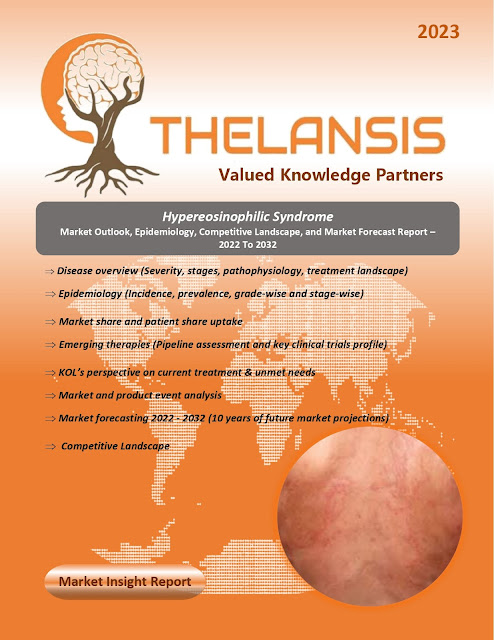Hypereosinophilic Syndrome (HES) – Market Outlook, Epidemiology, Competitive Landscape, and Market Forecast Report – 2022 To 2032
Hypereosinophilic Syndrome (HES) is a group of disorders characterized by elevated blood eosinophil counts (>1.5 × 109/L) and resultant organ damage, commonly affecting the heart. Initially, the term referred to the combination of peripheral blood eosinophilia and tissue infiltrates leading to dysfunction or damage. The "idiopathic" label reflected the lack of knowledge regarding underlying causes, excluding known diseases such as drug allergies, parasitic infections, cancer, lymphoma and myeloproliferative disorders. Symptoms of HES can vary greatly among patients and include skin rashes, dizziness, memory loss, coughing, shortness of breath, fatigue, fever, and mouth sores. Organ damage or dysfunction occurs due to the release of cytotoxic substances by eosinophils, including eosinophil cationic protein, major basic protein, ribonuclease eosinophil derived neurotoxin, eosinophil peroxidase, and enzymes such as elastase and collagenase. Eosinophils also secrete cytokines and chemokines, contributing to the immune response, and can lead to fibrotic changes due to increased collagen synthesis. Current diagnostic criteria for HES suggest that two distinct mechanisms may underlie chronic, unexplained hypereosinophilia in HES patients. One mechanism involves a sporadic hematopoietic stem cell mutation resulting in clonal expansion of eosinophilic cells, and the other involves an overproduction of eosinophilopoietic cytokines by activated T cells. Classifying HES patients can be challenging and requires specialized laboratory evaluation. Predominant skin symptoms without heart involvement, along with serum hyper IgE or polyclonal hypergammaglobulinemia, may suggest the lymphocytic variant of HES. Treatment options for HES include high-dose oral corticosteroids, interferon alpha, hydroxyurea, and PUVA therapy. Approximately 70% of patients respond to oral prednisone therapy with normalization of eosinophil counts. The 5-year survival rate for HES patients is 80%, with heart failure being the most common cause of death.
·
The incidence of HES ranged from 0.04 to 0.17
per 100,000 individuals.
Thelansis’s “Hypereosinophilic
Syndrome (HES) Market Outlook, Epidemiology, Competitive Landscape, and Market
Forecast Report – 2022 To 2032" covers disease overview, epidemiology,
drug utilization, prescription share analysis, competitive landscape, clinical
practice, regulatory landscape, patient share, market uptake, market forecast,
and key market insights under the potential Hypereosinophilic Syndrome (HES)
treatment modalities options for eight major markets (USA, Germany, France,
Italy, Spain, UK, Japan, and China).
KOLs insights
of Hypereosinophilic Syndrome (HES) across 8 MM market from the centre of
Excellence/ Public/ Private hospitals participated in the study. Insights
around current treatment landscape, epidemiology, clinical characteristics,
future treatment paradigm, and Unmet needs.
Hypereosinophilic Syndrome (HES) Market Forecast Patient
Based Forecast Model (MS. Excel Based Automated Dashboard), which Data Inputs
with sourcing, Market Event, and Product Event, Country specific Forecast
Model, Market uptake and patient share uptake, Attribute Analysis, Analog
Analysis, Disease burden, and pricing scenario, Summary, and Insights.
Thelansis Competitive Intelligence (CI) practice
has been established based on a deep understanding of the pharma/biotech
business environment to provide an optimized support system to all levels of
the decision-making process. It enables business leaders in forward-thinking
and proactive decision-making. Thelansis supports scientific and commercial
teams in seamless CI support by creating an AI/ ML-based technology-driven
platform that manages the data flow from primary and secondary sources.




Comments
Post a Comment